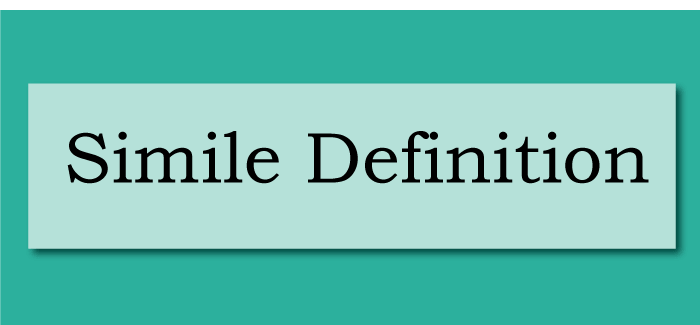Simile DefinitionA simile is an artistic expression contrasting two things that match features or properties. Similes and metaphors, which are two different expressions used for comparison, are sometimes misunderstood. 
To distinguish a simile from a metaphor, search for "like" or "as." So, the words "as" or "like," such as "as attractive as a peacock," is an outstanding example of similes. Use of Similes: Why It's ImportantA simile is a figure of speech typically used to compare two or more items with similar qualities. Similes are essential to add interest, explanation, and creativity to speech. Similes can inspire more powerful descriptions than words or exact definitions like the mind thinks in images and ideas. When Should You Use a Simile in a Sentence?When comparing two or more nouns in a phrase, a simile is utilized, and this is completed by utilizing words like "as" or "like". The central concept behind using the word "as" in a simile is to use a well-known noun for a particular feature. For example, "as busy as a bee" or "as attractive as a peacock," etc. A simile is a simple comparison of two similar or dissimilar things. A simile enhances the reader's or listener's understanding of the quality of the nouns and helps them see and comprehend it. Distinction Between a Simile and a MetaphorBoth similes and metaphors are instances of figurative language and kinds of comparison. Although a simile is a metaphor, there is a significant difference between these two literary concepts. "As" or "like" are utilized to compare two things in a simile. In contrast, a metaphor uses a direct analogy for rhetorical impact. History and Etymology of the Simile
Simile was Originally Known to be Used Around The 15th CenturySimiles were first used in writing in the 15th century. A simile illustrates how two related things are similar in some aspect via comparison. A simile can be utilized in comedy or drama. Some Examples of SimilesNow that you know what a simile is, we have a comprehensive list of few of the popular simile examples. Look out for the similes listed below: 1. As oblivious as a bat Example: When my uncle doesn't have his glasses, he is as oblivious as a bat 2. As calm as a cucumber Example: As the results were about to be announced, the rest of us were all in a frenzy, but Arpita remained calm as a cucumber. 3. As courageous as a lion Example: The soldier was as courageous as a lion throughout the conflict. 4. Clever like a fox Example: He is clever like a fox, so don't believe a word he says. 5. As energetic as a bee Example: Every morning, my mother is as energetic as a bee 8. As white as a ghost Example: Riya's face turned as white as a ghost , when she found the thief inside her home. 9. As soft as silk Example: Piya simply love her new shawl it is as soft as silk. 10. As attractive as a peacock Example: Diana looks as attractive as a peacock 11. As royal as a princess Example: Navya's new costumes are very nice, and she looks as royal as a princess in that costume. 12. As fresh as a lotus Example: Swara's face looks as fresh as a lotus. 13. As angry as a lion Example: Dubey uncle was as angry as a lion when the bike was stolen. 14. As sweet as cuckoo Example: Rima sings so well, and her voice is as sweet as cuckoo. 15. As humble as a cow Example: Arnav has a very good nature, and he is as humble as a cow. How are Similes Used in Language?As we already know, similes are comparison expressions that emphasize similarities between two things and make comparisons between them while constantly using the words "like" or "as." We now need to know how to use similes in writing, especially in creative genres. Some guidelines for utilizing similes in the classroom:
Next TopicSocial Change Definition
|
 For Videos Join Our Youtube Channel: Join Now
For Videos Join Our Youtube Channel: Join Now
Feedback
- Send your Feedback to [email protected]
Help Others, Please Share










